A little waterway, which became known as the Tank Stream is of great historical significance to Sydney. But Sydneysiders wander the city streets, mostly oblivious that it runs beneath their feet. So here’s a short thread to help you know. 

The Gadigal People are Indigenous inhabitants of the southern side of Sydney Harbour and relied on this waterway as one of several freshwater sources, for thousands of years. It was a stream of barely 2km, flowing from a swampy area immediately east of Hyde Park to Circular Quay. 

When the First Fleet brough European settlers to Australia in 1788, they had initially planned to establish a Colony at Botany Bay. But Captain Athur Phillip found several things lacking at Botany Bay, one of which was a shortage of high-quality fresh drinking water. 

Heading north, Phillip entered Port Jackson. He planted his flag on the shores of a deep and sheltered bay, which he named Sydney Cove. Among its favourable attributes was a freshwater stream, which emptied into the Cove (look closely in this picture). 

In addition to providing fresh water, this little stream served as a social divider. Marine corps (and most convicts) camped to the west of it, gentry and naval officers to the east. Over the dividing stream, a log bridge was built, in a location that soon became Bridge Street. 

Severe drought struck the colony 1790. As Phillip wrote the following year, “so little rain has fallen that most of the runs of water in the different parts of the harbour have been dried up for several months, and the run which supplies this settlement is greatly reduced”. 
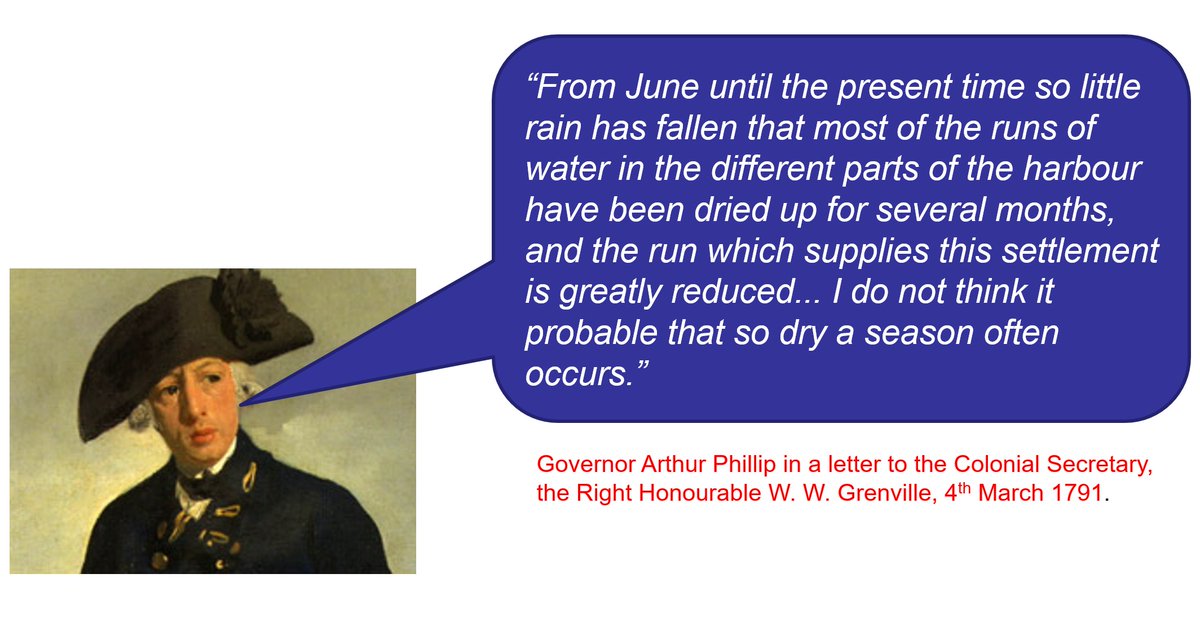
So in 1790 three were 'tanks’ cut into the bedrock of the stream, to enable water storage, and the waterway became known at the Tank Stream. See these tanks marked on this 1807 map, north of the “small bridge” on Hunter Street (the dog-legged street running east-west). 

In 1791 Governor Phillip had the Tank Stream enclosed with a fence to prevent pollution by animals. But with increasing population, land clearing, and building construction, pollution increased. This included human and animal wastes. 

In 1792 a stone arch bridge was constructed, replacing existing wooden structures. This was the first European-constructed stone bridge in Australia. Its foundations may well survive within the streambed under the traffic of modern Bridge Street. 

As the colony grew, pollution of the Tank Stream worsened. In response, in 1795, orders were made to prevent grazing of stock or cutting of trees within 15m of the stream. 

But these pollution-prevention measures were ultimately unsuccessful. The colony grew further, producing waste and runoff. In an effort to prevent stormwater pollution of the drinking water supply, drains were constructed, either side of the Tank Stream in 1810. 

A map of Sydney from 1822 shows the Tank Stream running through a highly developed township, from its source (around Market Street), under King Street, Hunter Street and Bridge Street, before reaching Sydney Cove. 
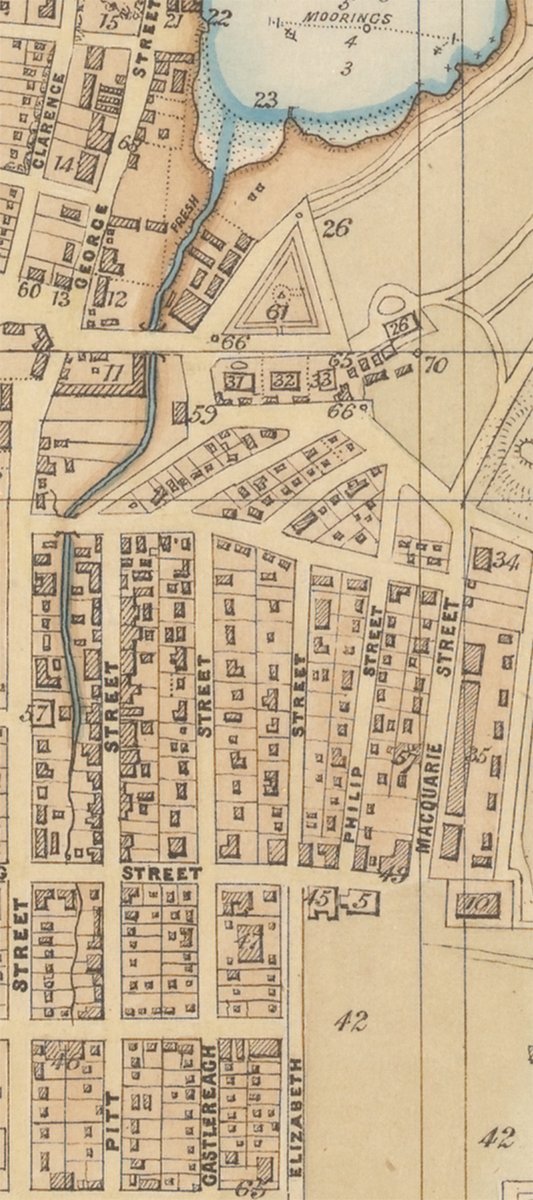
By 1826, the Tank Stream was so thoroughly polluted that Governor Brisbane disallowed its use for drinking and several wells were dug to provide cleaner water. The Tank Stream had become an unofficial sewer. 

Nonetheless, it remained a prominent geographical feature of early Sydney. This map of 1833 has it marked with the somewhat loftier name “Stream of the Tanks”. 

But in the 1850s work commenced in covering the Tank Stream between Bridge Street and Hunter Street, partially to reduce odours. The form of the channel was a mixture of stone and brick in the lower half, with a sandstone block arch cover. 
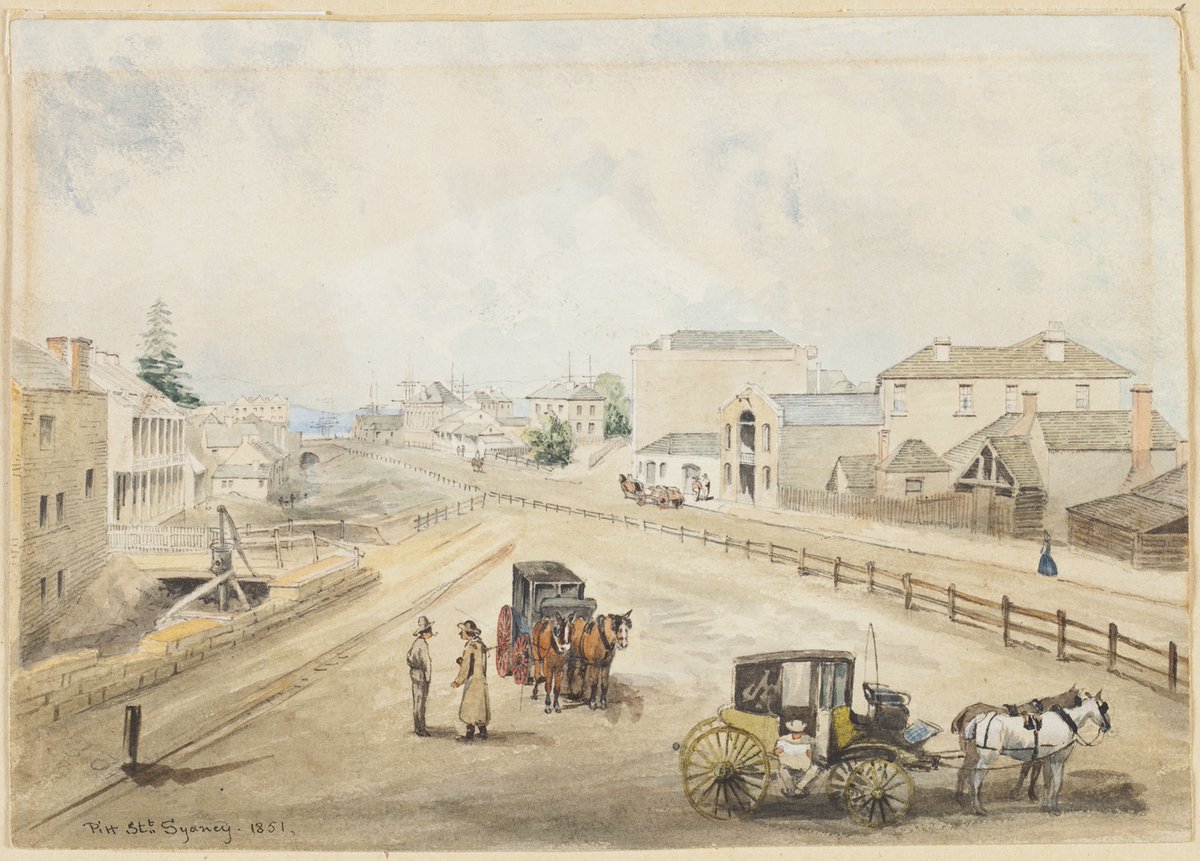
With drainage works, much of the wide mouth of the Tank Stream (below Bridge Street) could be reclaimed for development and Pitt Street -which had previously ended at Hunter Street- was extended north, crossing Bridge Street to Circular Quay. 
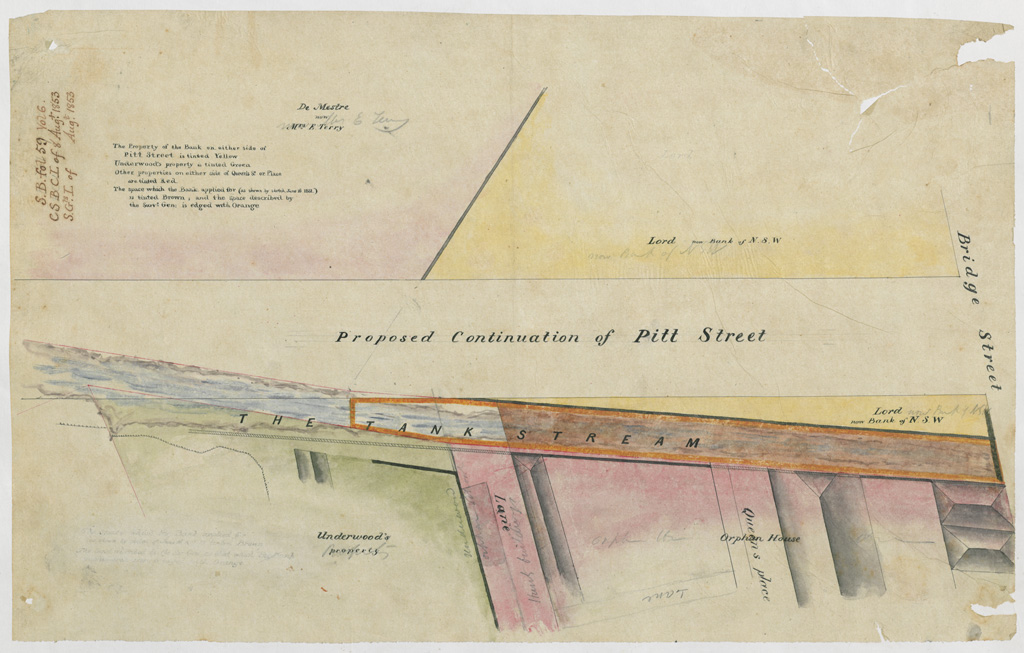
The Tank Stream now crosses under this lower section of Pitt Street, from the western side to the eastern side. In 1853 a temporary bridge was proposed across the stream, adjacent to “Mrs Reiby’s Property” (now the location of Reiby Place). 

This map from 1856 shows that “wooden bridge” in place and the Tank Stream now discharging to Sydney Cove, entirely to the east of Pitt Street. 

Upstream sections (south of Hunter Street) were also enclosed as the “New Sewer in Pitt Street” in 1857. These sections were constructed from brick in an arch to ‘oviform’ shape. This shape provided strength as well as maintaining movement of water under low-flow conditions. 

The Tank Steam went from unofficial sewer official sewer. Soon Sydney Harbour was polluted, and a series of sewage pumping stations were built around 1900 to transfer sewage to the Bondi Ocean Outfall Sewer. Read about those sewage pumping stations here:
https://twitter.com/stukhan/status/1406147542597832708
Land above the tank steam, which had been Crown Land was sold-off in the early 1900s. This image shows a plan for five ‘perches’ of Tank Stream Crown Land being sold in 1912. This is the current location of Angel Place and the City Recital Hall. 

The Tank Steam is now a heritage-listed Sydney Water stormwater drain. The route is shown on this Heritage Plan, with the three known ‘tanks’ shown as circles, between Curtain Place and Bond Street. This area is now Australia Square Plaza and the Plaza Building (95 Pitt Street). 

It is also here that Sydney Water have an access point to the Tank Stream, which they use for inspections and maintenance. The entrance is down a short flight of stairs and is marked by an informational plaque, placed here as part of a NSW Bicentennial project in 1988. 

That plaque acknowledges the “gift to the people of Sydney of public access to the Tank Stream”, and occasionally, this access point is used to provide guided tours of the Tank Stream, between Curtain Place and Hunter Street. It runs -appropriately- beneath The Tank Stream Hotel. 

I was fortunate to join a Tank Stream tour in 2014. There are only a few each year and most tickets are selected by lottery. The Lottery is run by Sydney Living Museums if you want to give it a go (sydneylivingmuseums.com.au/tags/tank-stre…). None currently available, -which is sadly fairly normal. 

On the sandstone bedrock, you can see chips made by the pickaxes of the convicts that worked on it, perhaps as far back as 1790. And you can observe the V profile, cut into the bedrock to facilitate water flow. In some sections, the arched sandstone roof is high enough to stand. 

Further up the Tank Stream tour, the oviform sewer appears. You can see that it looks just as it did in the 1857 sketch of ‘Making the New Sewer in Pitt Street’. 

Also visible is one of the world's oldest dedicated sewers, the Bennelong Point Sewerage System. Built in 1857, this system brought sewage from Pitt, Castlereagh, Elizabeth, Phillip and Macquarie Streets to Bennelong Point, protruding out into Sydney Harbour. 

Another place to see the Tank Stream is from the basement of the GPO Building in Martin Place. Beneath the clock tower, there’s a small viewing area. It's currently closed, but you might be able to nip down, or else do what I did and take the free Fullerton Hotel guided tour. 

Here’s what you’ll see. Yes, its just an external view of a partially exposed brick drain, adjacent to a modern concrete drain. But if you’ve read this far, I assume you’ll agree that it’s still a very special brick drain. 

Nearby, protected behind a sheet of glass, is a short, excavated cross-section of the brick-lined Tank Stream sewer. Here again you can clearly observe the ‘oviform’ shape and the resemblance to the 1857 sketch shown earlier in this thread. 

The Tank Stream is also remembered by the Tank Stream Fountain, which sits at ‘Herald Square’. This was donated in 1981 by John Fairfax & Sons, to commemorate the 150th anniversary of the first publication of the Sydney Morning Herald. 

The Tank Stream is prominently marked on this large ‘bench map’ of Circular Quay in First Fleet Park. It shows the broad tidal estuary the stream formed. Note the faintly marked contours of the current ferry wharves, showing how the mouth has now been fully covered. 

So back to the point: How will you know when you’re walking above the Tank Stream? You’ll be doing that when you cross Market Street, between Pitt and George; when you shop at Myer, MidCity or the Strand Arcade. 







You’ll cross the Tank Stream when you walk down King Street, between Pitt and George; when you pass the war memorial in front of the GPO, when you queue for the City Recital Hall in Angel Place, and when you pass the Grand Hotel on Hunter Street. 







You'll cross it at the lowest dip on Bond Street, at the entrance to the Australia Square Car Park. You’ll follow its course down Tank Stream Way to Tank Stream Bar. You might walk right over the relics of Sydney’s first stone arch bridge as you cross Bridge Street, west of Pitt. 







You can follow the Tank Stream down the last stretch of Pitt Street. You might cross relics of a little wooden bridge around Reiby Place. The Tank Stream runs beneath as you wait for the light rail. And it runs into the Harbour, beneath the feet that pass by No. 6 Ferry Wharf. 



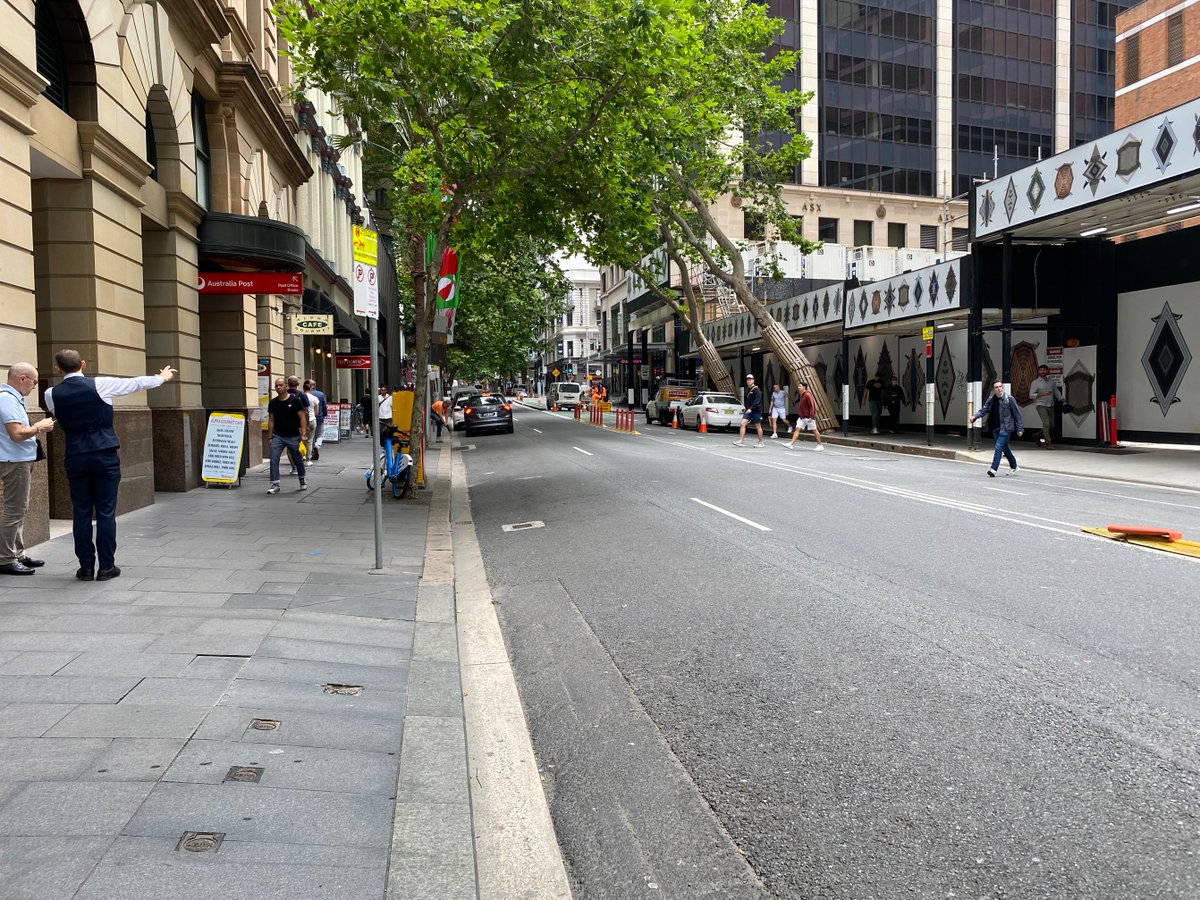



• • •
Missing some Tweet in this thread? You can try to
force a refresh













